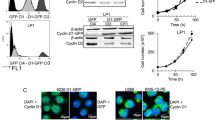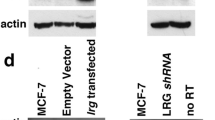Abstract
Purpose. Recently, MDR1 (P-glycoprotein) and related transporters have been suggested to play a fundamental role in regulating apo- ptosis, but little information is available concerning the role of MDR1. Here, the effect of apoptotic stimuli on the MDR1 mRNA and apoptotic signaling was examined in MDR1-overexpressing cells.
Methods. The expression levels of mRNA for MDR1, MRP1, MRP2, p53, p21, Bax, and Bcl-2 were measured by real time quantitative polymerase chain reaction in HeLa and its MDR1-overexpressing sublines. The effects of apoptotic stimuli by cisplatin (CDDP) on their levels were also assessed as well as on caspase 3, 8, and 9 activities.
Results. MDR1 was rapidly upregulated when the cells were exposed to apoptotic stimuli by CDDP. The increase in Bax mRNA to Bcl-2 mRNA ratio after treatment with CDDP was suppressed in MDR1-overexpressing cells. The increases in caspase 3 and 9 activities after treatment with CDDP were suppressed in MDR1-overexpression cells.
Conclusion. MDR1 is upregulated by apoptotic stimuli suppressed apoptotic signaling presumably via the mitochondrial pathway.
Similar content being viewed by others
REFERENCES
D. M. Bradshaw and R. J. Arceci. J. Clin. Oncol. 16:2674–2690 (1998).
R. L. Juliano and V. Ling. A surface glycoprotein modulating drug permeability in Chinese hamster ovary cell mutants. Biochim. Biophys. Acta. 455:152–162 (1976).
K. Ueda, A. Yoshida, and T. Amachi. Recent progress in Pglycoprotein research. Anti-Cancer Drug Design 14:115–121 (1999).
C. Ramachandran and S. J. Melnick. Multidrug resistance in human tumors-molecular diagnosis and clinical significance. Mol. Diagnosis 4:81–94 (1999).
K. Ueda, D. P. Clark, C. Chen, I. B. Roninson, M. M. Gottesman, and I. Pastant. The human multidrug resistance (mdr1) gene. J. Biol. Chem. 262:505–508 (1987).
K. Ueda, C. Cardarelli, M. M. Gottesman, and I. Pastant. Expression of full-length cDNA for the human “MDR1” gene confers resistance to colchicine, doxorubicin, and vinblastine. Proc. Natl. Acad. Sci. USA 84:3004–3008 (1987).
F. Thiebaut, T. Tsuruo, H. Hamada, M. M. Gottesman, I. Pastant, and M. C. Willingham. Cellular localization of the multidrug-resistance gene product P-glycoprotein in normal human tissues. Proc. Natl. Acad. Sci. USA 84:7735–7738 (1987).
H. Kusuhara, H. Suzuki, and Y. Sugiyama. The role of P-glycoprotein and canalicular multispecific organic anion trasnporter in the hepatobiliary excretion of drugs. J. Pharm. Sci. 87:1025–1040 (1998).
Y. Tanigawara. Role of P-glycoprotein in drug disposition. Ther. Drug Monit. 22:137–140 (2000).
C. J. Matheny, M. W. Lamb, K. L. R. Brouwer, and G. M. Pollack. Pharmacokinetic and pharmacodynamic implications of P-glycoprotein modulation. Pharmacotherapy 21:778–796 (2001).
P. M. Chaudhary and I. B. Roninson. Expression and activity of P-glycoprotein, a multidrug efflux pump, in human hematopoietic stem cells. Cell 66:85–94 (1991).
A. S.-F. Chong. P. N. Markham, H. M. Gebel, S. D. Bines, and J. S. Coon. Diverse multidrug-resistance-modification agents inhibit cytolytic activity of natural killer cells. Cancer Immon. Immunother. 36:133–139 (1993).
W. T. Klimecki, B. W. Futscher, T. M. Grogan, and W. S. Dalton. P-Glycoprotein expression and function in circulating blood cells from normal volunteers. Blood 83:2451–2458 (1994).
G. J. Randolph, S. Beaulieu, M. Pope, I. Sugawara, L. Hoffman, R. M. Steinman, and W. A. Muller. A physiologic function for p-glycoprotein (MDR-1) during the migration of dendritic cells from skin via afferent lymphatic vessels. Proc. Natl. Acad. Sci. USA 95:6924–6929 (1998).
G. Raghu, S. W. Park, I. B. Roninson, and E. B. Mechetner. Monoclonal antibodies against P-glycoprotein, an MDR1 gene product, inhibit interleukin-2 release from PHA-activated lymphocytes. Exp. Hematol. 24:1258–1264 (1996).
J. Drach, A. G. Gsur, G. Hamilton, S. Zhao, J. Angerler, M. Fiegl, N. Zojer, M. Raderer, I. Haberl, M. Andreeff, and H. Huber. Involvement of P-glycoprotein in the transmembrane transport of interleukin-2 (IL-2), IL-4, and interferon-γ in normal human T lymphocytes. Blood 88:1747–1754 (1996).
C. K. van Kalken, G. Giaccone, P. van der Valk, C. M. Kuiper, M. M. N. Hadisaputro, S. A. A. Bosma, R. J. Scheper, C. J. L. M. Meijer, and H. M. Pinedo. Multidrug resistance gene (P-glycoprotein) expression in the human fetus. Am. J. Pathol. 141:1063–1072 (1992).
A. Macfarland, D. R. Abramovich, S. W. B. Ewen, and C. K. Pearson. Stage-specific distribution of P-glycoprotein in first-trimester and full-term human placenta. Histochem. J. 26:417–423 (1994).
K. D. Bunting, J. Galipeau, D. Topham, E. Benaim, and B. P. Sorrentino. Transduction of murine bone marrow cells with an MDR1 vector enables ex vivo stem cell expansion, but these expanded grafts cause a myeloproliferative syndorome in transplated mice. Blood 92:2269–2279 (1998).
R. W. Johnstone, A. A. Ruefli, and M. J. Smyth. Multiple physiological functions for multidrug transporter P-glycoprotein? Trends Biochem. Sci. 25:1–6 (2000).
R. W. Johnstone, A. A. Ruefli, K. M. Tainton, and M. J. Smyth. A role for P-glycoprotein in regulating cell death. Leukemia Lymphoma 38:1–11 (2000).
J. M. Adams and S. Cory. The Bcl-2 protein family: arbiters of cell survival. Science 281:1322–1326 (1998).
M. Pollack and C. Leeuwenburgh. Apoptosis and aging: role of mitochondria. J. Gerontology 56A:B475–482 (2001).
J. D. Robertson and S. Orrenius. Molecular mechanisms of apoptosis induced by cytotoxic chemicals. Crit. Rev. Toxicol. 30:609–627 (2000).
M. J. Smyth, E. Krasovskis, V. R. Sutton, and R. W. Johnstone. The drug efflux protein, P-glycoprotein, additionally protects drug-resistant tumor cells from multiple forms of caspasedependent apoptosis. Proc. Natl. Acad. Sci. USA 95:7024–7029 (1998).
R. W. Johnstone, E. Cretney, and M. J. Smyth. P-Glycoprotein protects leukemia cells against caspase-dependent, but not caspase-independent, cell death. Blood 93:1075–1085 (1999).
N. Iida, K. Takara, N. Ohmoto, T. Nakamura, T. Kimura, A. Wada, M. Hirai, T. Sakaeda, and K. Okumura. Reversal effects of antifungal drugs on multidrug resistance in MDR1-overexpressing HeLa cells. Biol.Pharm.Bull. 24:1032–1036 (2001).
Y. A. Hannun. Apoptosis and the dilemma of cancer chemotherapy. Blood 89:1845–1853 (1997).
D. P. Guimaraes and P. Hainaut. TP53: a key gene in human cancer. Biochimie 84:83–93 (2002).
J. A. Bush and G. Li. Cancer chemoresistance: the relationship between p53 and multidrug transporters. Int. J. Cancer 98:323–330 (2002).
Author information
Authors and Affiliations
Corresponding author
Rights and permissions
About this article
Cite this article
Sakaeda, T., Nakamura, T., Hirai, M. et al. MDR1 Up-Regulated by Apoptotic Stimuli Suppresses Apoptotic Signaling. Pharm Res 19, 1323–1329 (2002). https://doi.org/10.1023/A:1020302825511
Issue Date:
DOI: https://doi.org/10.1023/A:1020302825511




